Bury, Lancashire
Up to 1834
In 1728, a proposal to erect a poorhouse in Bury was rejected by the Vestry meeting. However, there was apparently a change of mind in 1731-2 when the scheme was approved.
In a parliamentary report of 1777, Bury was listed as having a workhouse with accommodation for 50 inmates. Eden, in his 1797 survey of the poor in England, reported of Bury that:
Bury's workhouse, also known as the Redvales workhouse, was erected in 1775 to the south of the town on the Manchester Road. Up until 1810, it was managed by the town's oveerseers, then a separate manager was appointed. In 1826, the Vestry expressed the opinion that the "workhouse in its present state is not sufficiently large to afford an opportunity of employing the inmates in useful labour nor such conveniences as are essential for the health of such an establishment." A new wing was then added at the eastern end of the building.
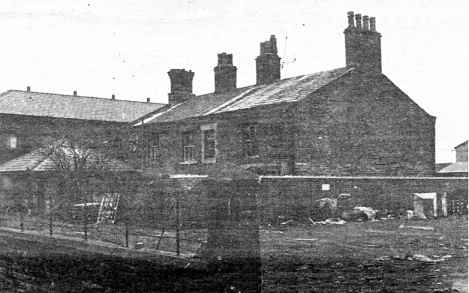
Bury's Redvales workhouse.
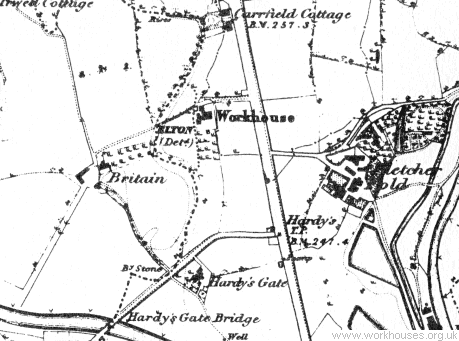
Bury Redvales workhouse site, 1848.
Township workhouses also operated on Blackburn Street at Radcliffe, on Bury Old Road to the west of Heywood, on Pot Green (where house numbers 13-20 now stand) at Holcombe Brook in Tottington Lower End, and at Elton.
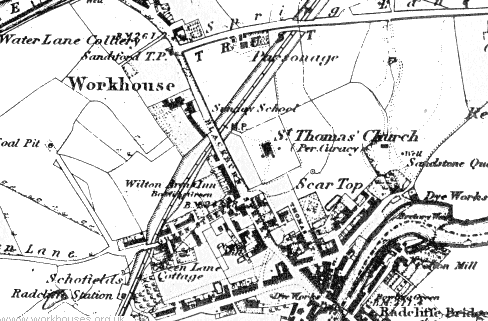
Radcliffe workhouse site, 1848.
The Pilkington workhouse on Moss Lane at Whitefield also included a school.
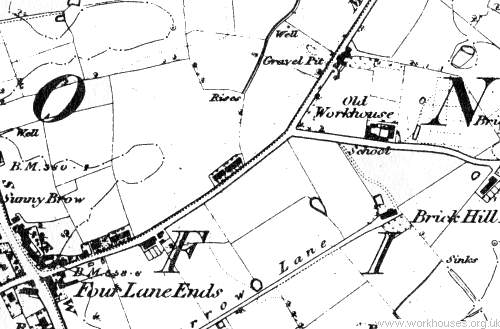
Pilkington workhouse site, 1848.
The Heywood workhouse was at the corner of Heap Lane (now part of Bury Old Road) and Livsey Lane, Heap, and is highlighted in yellow on the map below.
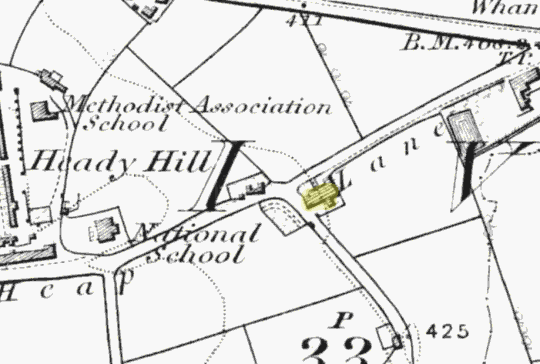
Hewyood workhouse site, 1848.
After 1834
The Bury Poor Law Union was formally declared on 8th February 1837. Its operation was overseen by an elected Board of Guardians, 25 in number, representing its 12 constituent parishes and townships as listed below (figures in brackets indicate numbers of Guardians if more than one):
Lancashire: Ainsworth, Ashworth, Birtle-cum-Bamford, Bury (5), Elton (2), Heap (3), Hopwood, Pilkington (3), Pilsworth, Radcliffe (2), Tottington Lower End (3), Walmersley (2).
The population falling within the union at the 1831 census had been 62,599 with parishes ranging in size from Ashworth (population 294) to Bury itself (15,086).
Initially, the Bury Union continued to use the old township workhouses at Bury, Radcliffe, Heywood, Heap, Tottington Lower End, and Pilkington. Until 1852, children were accommodated at the Pilkington workhouse but from that date most were sent to the Manchester Union's industrial Schools at Swinton. The Radcliffe workhouse appears to have housed only male paupers, with Heap used for females.
In May 1841, a report on the Heap workhouse noted that:
In 1850, Lord Derby refused to renew leases for the Bury, Heap and Pilkington workhouses which stood on his land, saying that the Guardians had "already spent as much money as would have built a union workhouse by paying extra salaries and not having a labour test." The followng year, the Poor Law Board proposed the building of a joint workhouse for Bury and the adjacent Union of Rochdale which was in a similar position. In 1852, the Bury Guardians borrowed £6,000 and advertised for plans for a workhouse to accommodate 400 inmates, with a separate 60-bed hospital. Work on the new buildings finally commenced in 1855 when a further £8,000 was borrowed. The workhouse opened on January 21st 1857, and a year later the total expenditure for the scheme had swollen to £20,481.
The new workhouse was erected at Jericho, almost two miles to the east of Bury, and a height of 461 feet above sea level. The location and layout are shown on the 1894 map below:
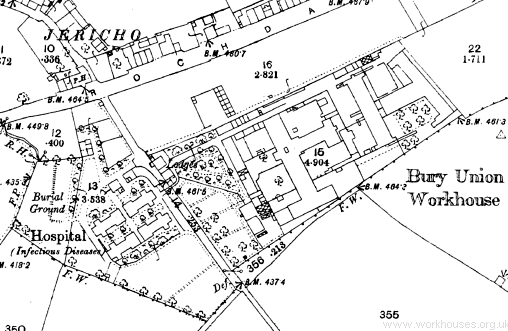
Bury workhouse site, 1894.
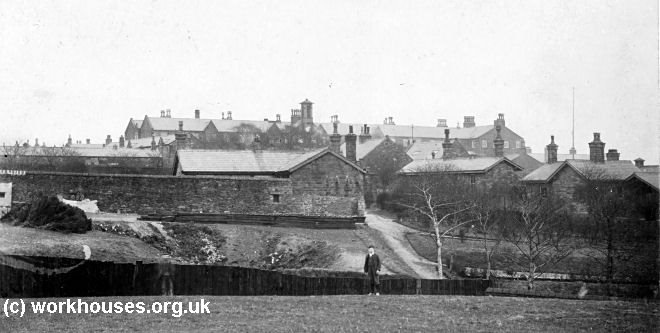
Bury workhouse from the west, c.1906.
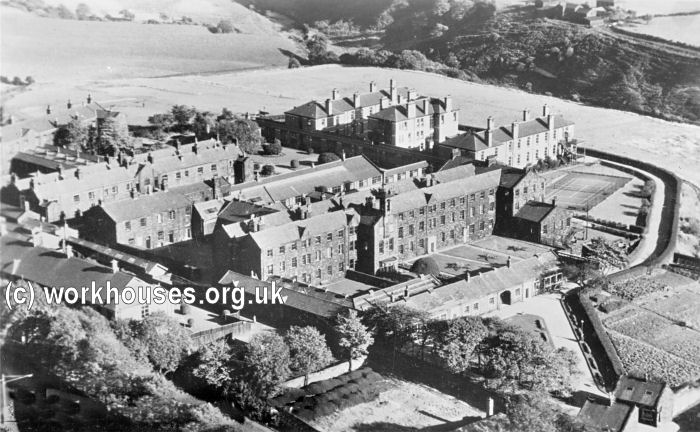
Bury workhouse from the north-west, c.1930s.
The main building (now demolished) was an asymmetrical T-shape with its entrance at the east. The irregular H-shaped building at the east was probably the original workhouse infirmary.
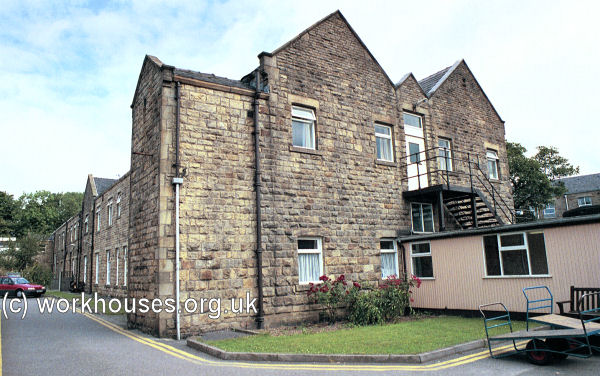
Bury original infirmary from the north, 2000.
© Peter Higginbotham.
Following a visit to the new workhouse in 1860, Joseph Rowntree of Leeds submitted a report to the Bury Times. It contained a number a number of critcisms about the workhouse.
Over the next twenty years, various additions were made including accommodation for infants in 1862, and for the insane in 1868. In 1876, a new 32-bed infectious hospital was built at the west of the site. It comprised four ward-blocks connected by a wide, open covered way, and was designed in conjunction with the Local Government Board. A contemporary report described the new wards as 'excellent in themselves and greatly in advance of anything hitherto attempted'. Additional buildings erected at the same time included a nurses' home and mortuary.
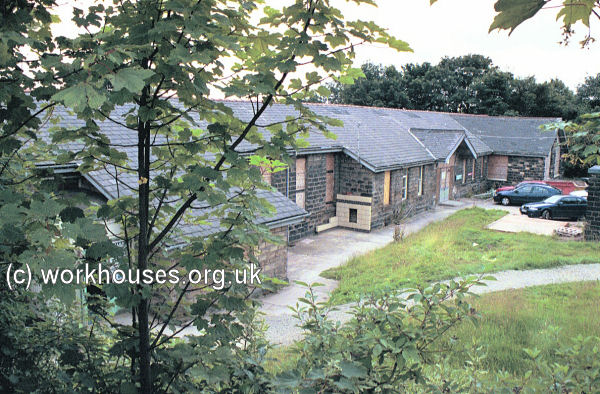
Bury infectious hospital from the east, 2000.
© Peter Higginbotham.
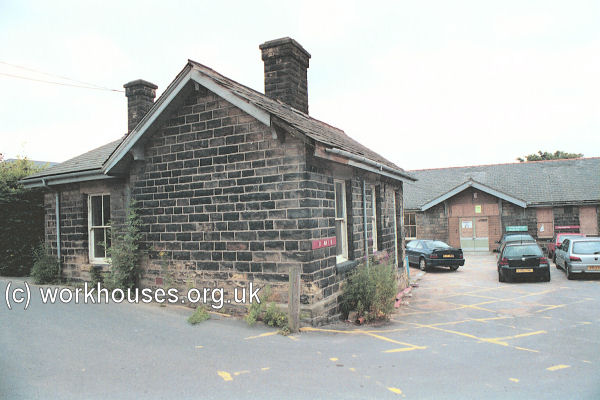
Bury infectious hospital from the north, 2000.
© Peter Higginbotham.
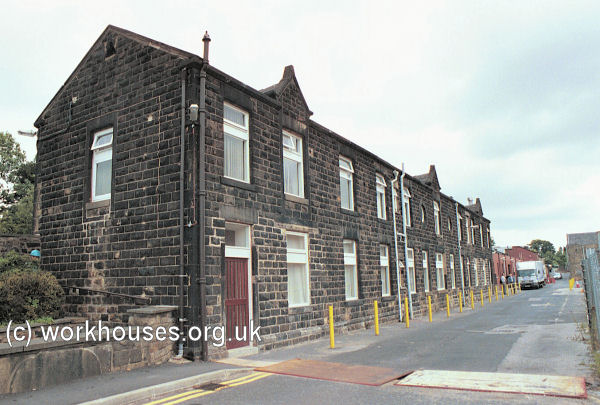
Bury accommodation block, 2000.
© Peter Higginbotham.
Following a visit to the workhouse in 1860, Joseph Rowntree of Leeds submitted a report to the Bury Times. It contained a number a number of critcisms about the workhouse including the infrequent visits of the doctor, the number of blankets provided to the the inmates, and the state of the boys' schoolroom and its occupants, both of which looked 'very forlorn and dirty'.
The workhouse had its own burial ground at the west of the site, as shown on the 1894 map above. This was not a common feature of English workhouses. Paupers who died in a workhouse whose bodies were not claimed by family or friends were usually buried in a local nearby churchyard in an unmarked grave. The Jericho workhouse cemetery is believed to have continued in use until 1916, by which time around 4,000 burials of deceased inmates had taken place there.
From 1904, to protect them from disadvantage in later life, the birth certificates for those born in the workhouse gave its address just as 1 Broad Oak Lane, Bury.
In 1903-5, a new 126-bed infirmary was erected to the south of the workhouse. Designed by A Hopkinson, and built from Accrington plastic bricks, it comprised a central administrative block flanked by two double pavilions. Accommodation for 17 nurses was provided in the administrative block.
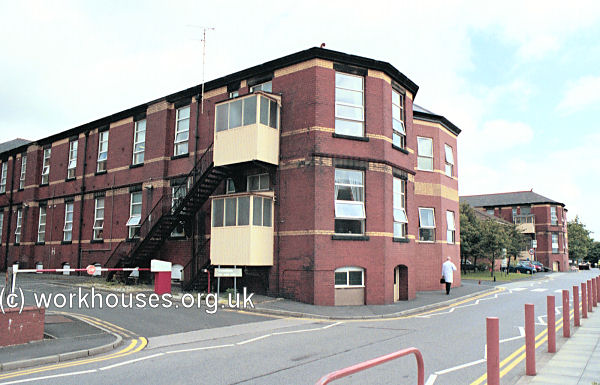
Bury new infirmary ward blocks from the south-west, 2000.
© Peter Higginbotham.
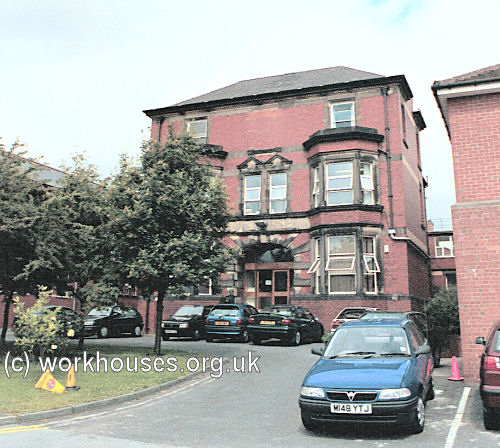
Bury new infirmary adminisirative block from the south-eaest, 2000.
© Peter Higginbotham.
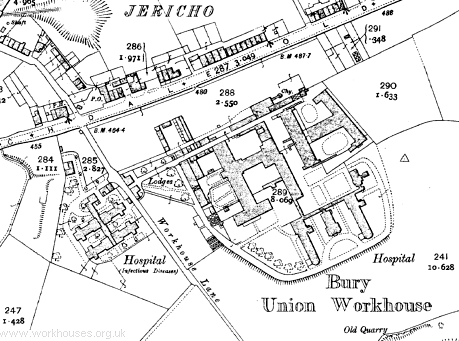
Bury workhouse site, 1908.
By 1912, the number of inmates in the workhouse was well over 700, including 83 children and vagrants. During the First World War, a military hospital was established in the new infirmary.
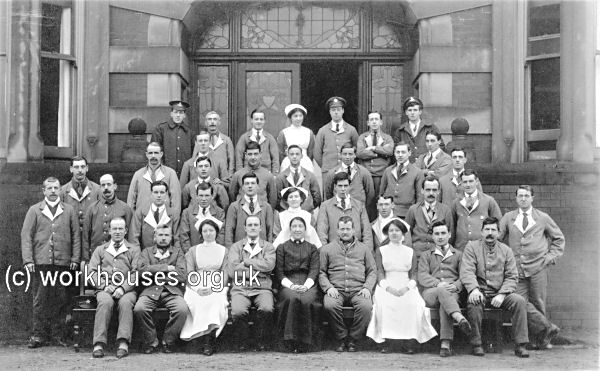
Bury workhouse military hospital patients and staff of 'D' Ward, 1917.
© Peter Higginbotham.
If an inmate died in the workhouse, their next of kin (if known) would be informed and invited to arrange a funeral. If this did not happen, the body would receive a paiuper's funeral and uried in an unmarked grave, usually with a number of other similar individuals.
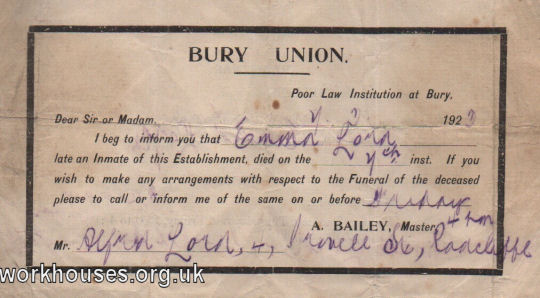
Bury workhouse death notice, 1923.
Courtesy of Geoff Turner.
The workhouse later became Bury Union Institution, then Jericho Public Assistance Institution. In 1940, it became a decontamination centre. In the same year, a bomb fell in the grounds but caused relatively little damage or injury.
The site is now known as Fairfield Hospital and most of the old workhouse blocks have been replaced by modern buildings.
The union erected offices on Parson's Lane in Bury which were opened in August 1866.
Staff
- Masters: Thomas and John Livsey (by 1828), John Hardman (by 1838), George Lord (1840-57).
- 1841 Census — Heap workhouse
- 1851 Census — Heap workhouse
- 1881 Census
Inmates
- Long-term workhouse inmates (1861)
- 1841 Census — Heap workhouse
- 1851 Census — Heap workhouse
- 1881 Census
Records
Note: many repositories impose a closure period of up to 100 years for records identifying individuals. Before travelling a long distance, always check that the records you want to consult will be available.
- Bury Archives Service, Bury Museum and Archives, Moss Street, Bury BL9 0DR. Holdings: Guardians' minutes (1840-1930); Admission and discharge registers (1864-7, 1871-81, 1885-6, 1897-1900, 1906-7); Creed Registers (1869-1934); Registers of burials at workhouse cemetery (1858-1946); Returns of paupers relieved (1871-1900).
- Find My Past has searchable Admission, Discharge and Creed registers.
Bibliography
- Higginbotham, Peter The Workhouse Encyclopedia (2014, The History Press)
Links
Acknowledgment
-
Thanks to Shirley Warburton for information on the Heap workhouse.
Unless otherwise indicated, this page () is copyright Peter Higginbotham. Contents may not be reproduced without permission.


